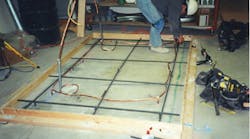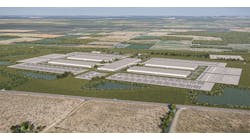The need to account for earthquake hazards in switchgear design affects nearly all of us
An earthquake will occur today. The same can be said for tomorrow and the day after. Most of these quakes will go unnoticed by everything but sensitive seismic instruments. Others will cause substantial, sometimes catastrophic, destruction. Most people in the United States incorrectly think of earthquakes as phenomena exclusive to California, but the unpredictability of where they will strike is well documented. For example, a magnitude 4.4 earthquake—considered capable of causing moderate damage by most seismic scales—hit Little Rock, Ark., an area generally considered safe from strong seismic activity, in May 2001. The quake occurred about 100 miles west of the New Madrid Fault, which slices through northeast Arkansas. In the mid-1800s, this fault was responsible for the most damaging earthquake ever to hit the United States—a two-day event strong enough to cause the Mississippi River to temporarily flow north. It’s this unpredictability that makes it important for you to protect your electrical equipment. Facilities managers typically have to worry about lightning when planning protection for their electrical equipment, but depending on where they’re located, they might also want to consider seismic protection for switchgear.
Knocking down earthquake myths. The National Earthquake Information Center (NEIC) estimates that 500,000 detectable earthquakes occur worldwide annually. Of these detectable quakes, 100,000 are strong enough to be felt without instrumentation and about 100 cause structural damage. Of the 42 states that record seismic magnitudes, 27 have experienced quakes above 5.4 on the Richter scale, the point at which quakes can cause significant damage.
Certain regions are more prone to earthquakes than others. The rim of the Pacific Ocean, for example, is home to a considerable amount of seismic activity. A small area of the United States experiences no earthquakes. In a 20-year span beginning in 1975 only four states—Florida, Iowa, North Dakota, and Wisconsin—failed to record any seismic activity. The Uniform Building Code (UBC) divides the country into six seismic zones. Zone 0 includes areas with the least potential for seismic damage, which account for roughly one-third of the country. Zone 1 has a low likelihood of seismic activity, and Zones 2A and 2B have moderate levels. Zones 3 and 4 have the most potential for catastrophic destruction. California has several Zone 4 regions, and the New Madrid Fault has also earned this classification (Figure).
Seismic-related failures, extended outages, and the likelihood of damage to switchgear increase as the Zone number goes up. However, you have an option for coping with your area’s earthquake potential—seismically certified switchgear.
Coping with quakes. Earthquake frequency and potential for damage, combined with the country’s growing reliance on a steady supply of power, have led to revisions in state and local building codes that strengthen a structure’s ability to withstand an earthquake. Many areas now mandate improved seismic design for buildings and equipment that have proven themselves to be cost-effective.
The UBC, the California Building Code (CBC), Building Officials and Code Administrators International, Inc. (BOCA), and the 2000 International Building Code (IBC) all list seismic load requirements for electrical distribution and power control equipment. To meet these updated building standards, companies are installing switchgear rated to withstand seismic activity.
Most electrical distribution equipment manufacturers place seismic ratings on their switchgear that are based only on calculations that predict how the equipment will react to a seismic event. Many manufacturers submit their equipment to national testing labs that simulate seismic activity for certification. To understand some of the language used in the certification, see the Sidebar on page 56.
UBC guidelines for seismic switchgear components specify that the test response spectrum be based on a 5% minimum damping factor, a peak of 2.15gs (3.2 Hz to 11 Hz) and a zero period acceleration (ZPA) of 0.86gs applied at the base of the equipment. Natural equipment frequencies must be at least 35 Hz. Most earthquake frequencies range from 10 Hz to 30 Hz. Seismic activity will adversely affect equipment with natural frequencies that fall within this range.
Seismic switchgear certification requires switchgear components, cabinets, anchoring mounts, and connections to pass shake table testing for a specific zone. For example, equipment tested for New York City would have to pass Zone 2A requirements. If any of the equipment fails the shake table test, chances are the switchgear wouldn’t function following a typical seismic event in New York City.
Installation standards. Establishing equipment seismic capability is the first step toward certification. The next step is ensuring the installation methods meet certain standards. For example, you must anchor equipment to the building foundation in a way that prevents or minimizes damage during an earthquake. Improperly attached equipment can overturn or become so flexible that it shears the attachment devices and slides off its foundation. The embedded concrete anchors or steel attachments must be adequate to resist the forces established by the UBC.
Equipment manufacturers provide mounting recommendations based upon shaker table tests used to verify the seismic design of switchgear. These tests prove that a piece of equipment will continue to function after a seismic event. The equipment must be easy to reset soon after the event and keep its structural integrity. This doesn’t mean that circuit breakers and relays won’t trip offline during an event. Switchgear must have this capability for third party testing labs to give it a seismic certification.
A structural or civil engineer responsible for providing the correct attachment method. Manufacturers provide bolt-down locations and other mounting recommendations. The engineer then designs the type and depth of anchors, and suggests additional mounting requirements for the seismically certified switchgear.
The final step is a review of the electrical connections within the system. The designer must specify suitable interface methods. Bottom entry of conduits is the recommended method for switchgear and transformers, because the bottom will sway less than the top. For top entry, you may need to use seismic fittings or flexible conduit. You can use flexible bus to connect generators to busway, and insulating boots may improve the integrity of these installations.
Is it for you? Seismic switchgear helps limit the devastation of most seismic activity, both directly by protecting the switchgear and indirectly by maintaining essential power. The issue you must address is risk vs. cost. If you’re in a Zone 3 or Zone 4 area, the cost of seismic switchgear is easy to justify. As you move down the zone numbers, the considerations become more complex. Your insurer may be able to help you work through these considerations. Be sure to address the criticality of your operations and the possible collateral damage caused by loss of power.
Johnson is a sales engineer in the large construction project market segment of Eaton/Cutler-Hammer in Seattle.
Sidebar: Seismic Switchgear Terminology
Damping factor: The damping property of equipment limits the total amplification the equipment will experience at resonance. For example, assume two cabinets are identical in design, mounting, and weight. However, one cabinet is a welded structure and the other is a bolted structure. During an earthquake, the structural elements in the bolted cabinet will move relative to each other, causing friction and noise, so the seismic energy dissipates much faster than in the welded cabinet. Thus, the bolted cabinet will damp the energy more quickly than the welded cabinet, reducing the time for the seismic response to build up. The damping properties of a system are a direct indication of the system’s ability to dissipate earthquake energy. Without damping, equipment response amplification at resonance increases without bound. The higher the damping factor of the equipment, the lower its response curves. When comparing response spectrum curves, you must plot them with the same damping factor.
“g”: This variable represents the acceleration magnitude correlating to the resultant seismic forces on the equipment. The energy content of an earthquake can best be defined by a response spectrum curve, which plots acceleration (g) vs. the frequency in Hz.
Impact on the test: Acceleration (g), frequency, and the damping factor define the test response spectrum curve used for equipment evaluation.
ZPA: This is the acceleration magnitude that is the maximum response of rigid systems. A rigid system doesn’t amplify the motion of an earthquake. The ZPA at the high frequency end of the response spectrum directly defines the maximum acceleration of the earthquake.



